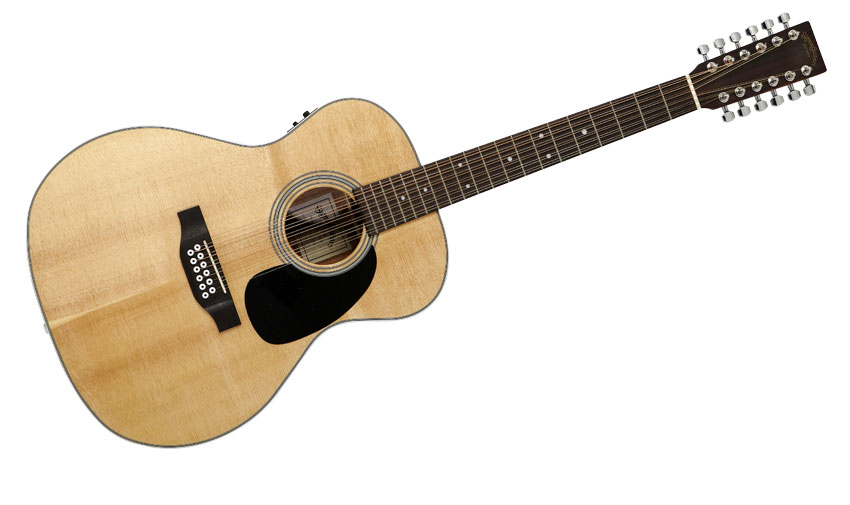MusicRadar Verdict
A guitar we never thought we needed until we played it! Excellent build and price. One for the collection.
Pros
- +
Affordability, quality build and inspiration.
Cons
- -
String-spacing. Large neck.
MusicRadar's got your back

Sigma JR12-1STE

Headstock
Having not seen a Martin-style jumbo for ages, Sigma brings along two at once. First the recently reviewed JRC-40E and now the 12-string JR12-1STE. This time, without the cutaway, we're treated to the full outline, which looks like a 000/OM on steroids.
This guitar hails from the lower level 1 Series, but in terms of woods it's supposedly identical to the aforementioned JRC-40E with laminated indian rosewood back and sides, a sitka spruce top and mahogany neck.
That said, the spruce top is darker with a less classic Sitka-like fine grain, and a less opaque satin to the neck reveals a very unlike-mahogany grain. Just remember, mahogany is a name applied to a huge variation of woods - this looks a little low grade.
"As you'd expect from a 12-string, it's a sizeable neck, wide at the nut and deep in the hand"
As you'd expect from a 12-string, it's a sizeable neck - wide at the nut and deep and full in the hand - it needs to be if it's going to stay straight with the added tension of the six extra strings.
The decoration is fairly utilitarian - chrome-plated tuners, unbound, dot-inlaid fingerboard, plain white back stripe, a black teardrop pickguard and an elongated unbound and satin- faced head - internally, things looks just as ship-shape.
As with many 12-strings that use a conventional pin bridge, actual spacing of the pairs is quite wide. That requires a little more care with left-hand fingering and, if we're honest, those picked arpeggios, which are so much a part of the 12-string canon, aren't as easy as some we've played.
Sounds
"Strumming the simplest of chords, it sounds like a chorus of angels have dropped in for a singsong"
Picking up the 12-string and strumming the simplest of chords, it sounds like a chorus of angels have dropped in for a singsong. It seems to have a similar bass-light, open mid voicing as the six-string, but it's almost perfect for the upper octaves of the lower four strings.
The neck, though, is quite a handful - those widely spaced pairs mean you have to be quite precise, especially for upper position parts. But at about half the price of the JRC, this ticks more boxes, both sonically and for its value for money.
The 12-string's preamp is sparse by comparison and its output is on a separate side panel that also houses the battery. It produces a bright tonality that can be tamed a bit, although some compression certainly helps, either thorough an amp or more obviously in a recording environment. The onboard tuner here is especially handy on the 12-string, even when you're playing acoustically.
All in all, its voluminous jangle is highly appealing. For experienced players wanting to add new flavours to compositions, our advice is to buy this and listen to Leo Kottke and you'll be heading off in a new direction. Not too shabby.
Dave Burrluck is one of the world’s most experienced guitar journalists, who started writing back in the '80s for International Musician and Recording World, co-founded The Guitar Magazine and has been the Gear Reviews Editor of Guitarist magazine for the past two decades. Along the way, Dave has been the sole author of The PRS Guitar Book and The Player's Guide to Guitar Maintenance as well as contributing to numerous other books on the electric guitar. Dave is an active gigging and recording musician and still finds time to make, repair and mod guitars, not least for Guitarist’s The Mod Squad.
“Built from the same sacred stash of NOS silicon transistors and germanium diodes, giving it the soul – and snarl – of the original”: An octave-fuzz cult classic returns as Jam Pedals resurrects the Octaurus
What’s the buzz? Meet Yellowjacket, Cherry Audio's recreation of EDP’s trend-setting Wasp from 1978
“A fabulous trip through all eight songs by 24 wonderful artists and remixers... way beyond anything I could have hoped for”: Robert Smith announces new Cure remix album










